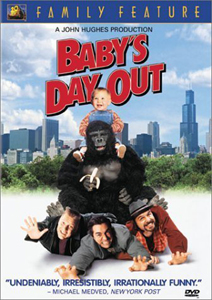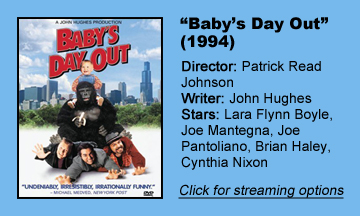Admittedly, I don’t watch a ton of movies with a baby in the lead role, but I gotta assume “Baby’s Day Out” (1994) – despite coming in the midst of his paycheck-grabbing 1990s remakes and light kiddie fare – is among John Hughes’ most creative concepts. How many movies follow a baby crawling around the big city?
This is one of Hughes’ good, not great, films, but director Patrick Read Johnson perhaps works harder to achieve that level than most merely good films because he has to get a performance out of a baby.
An expressive baby
The filmmakers find an expressive 9-month-old Baby Bink in the form of twins Adam and Jacob Worton. Bink’s cute expressions contrast with harrowing situations as he crawls atop skyscrapers and through traffic and hangs out with a gorilla.
These tense scenarios are initially hard to watch – even with 1994-era special effects, they look real enough — but composer Bruce Broughton uses a light playful score in this rare case where it’s important to communicate that this is just a movie.
After a way overlong kidnapping setup that prevents the film from getting higher marks, I started to delight in the absurdity rather than resist it. Half of the film’s success is Bink incongruously crawling around.
3 new stooges
The other half is the “Three Stooges”-esque trio of kidnappers: leader Eddie (Joe Mantegna), dimwit Norby (Joe Pantoliano) and muscleman Veeko (Brian Haley, very much holding his own with his bigger-name co-stars). Mantegna, leaning into his Fat Tony voice when intimidating his underlings, shows remarkable skill at slapstick and pratfalls.
The timing and pacing of the physical humor is sometimes strange. Eddie gets thrown by a gorilla into the bars of a cage and he just sticks there because the force was so extreme. Editor David Rawlins stays on that shot longer than you’d think would be wise for a comedy, yet it ends up making it funnier.
More gags land than don’t, but there are some misfires. Bink puts a lighter to Eddie’s crotch and – in order to keep the baby hidden under his coat from the police – Eddie puts up with the pain far longer than would be rational.
Mantegna’s facial expressions and utterances are gold, but the sequence is too long and completely unbelievable even within the film’s context. (Eddie could put his hand under his coat and flick off the lighter.)
Not afraid of contrasting tones
“BDO’s” sheer gall at telling this story with so many contrasting tones is admirable. The vertiginous skyscraper-under-construction sequence is terrifying, both for the oblivious baby and from the kidnappers’ POV, yet the things that happen to Eddie, Norby and Veeko are funny.
Even the fact that none of the workers notice their hijinks is worked into a social observation by Hughes: When the whistle blows, hundreds of workers drop what they’re doing and depart, leaving Eddie hanging in midair from a crane.
And then we’ll cut from the physical comedy and implausible unnoticed-baby scenario back to the heartbreak at Bink’s home, featuring tender moments such as the mother (Lara Flynn Boyle) telling the nanny (Cynthia Nixon) that her feelings for Bink matter, too.

“BDO” shouldn’t jell, but it does. I think it’s partly because the premise is so unabashedly absurd (and it’s made clear from the title, poster and short description) that we’re immediately in a pact with the movie to just go with it. This is far from Hughes’ deepest screenplay, and even the pratfalls are not his most creative.
And a tighter edit would’ve helped. Yet the great casting of the kidnappers and the great direction of the baby twins makes “Baby’s Day Out” bizarrely fun to watch.


